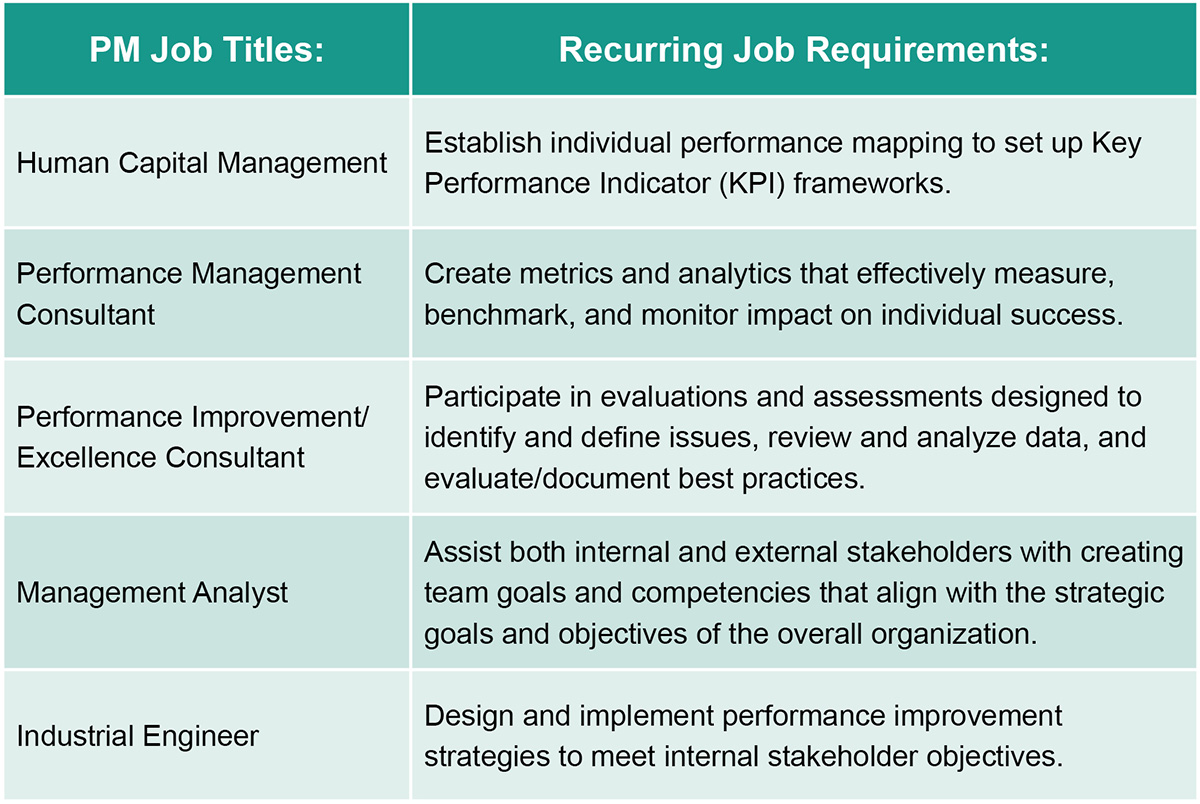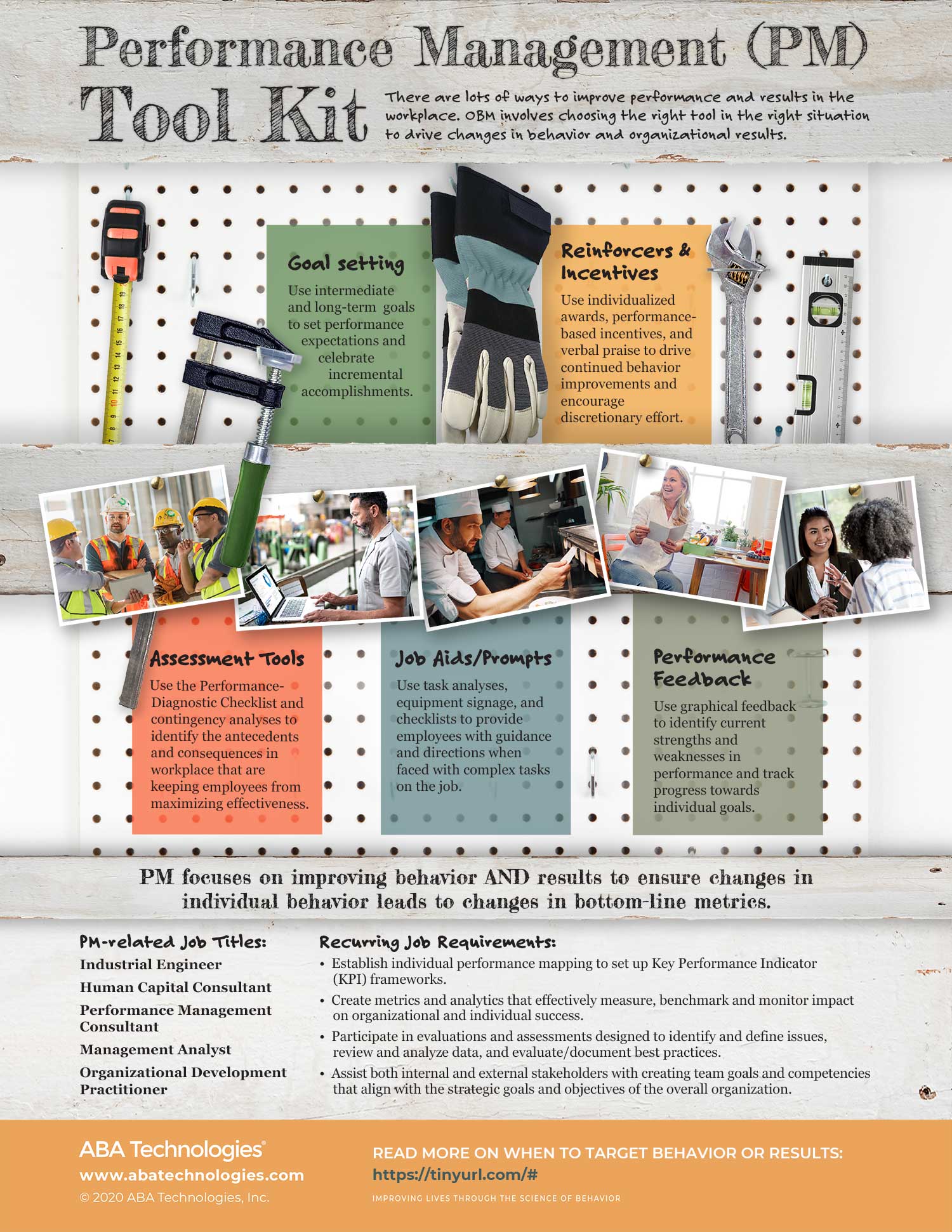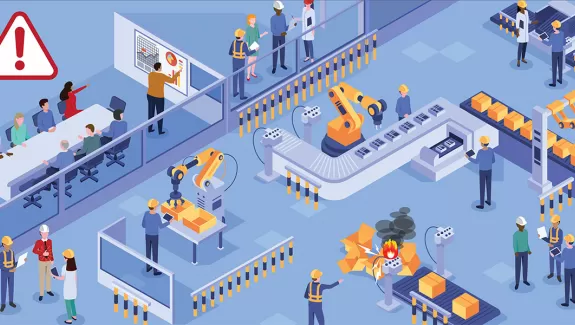
Performance Management
Author: Vincent Bello
Part 3 of 7
Performance Management
Performance Management (PM) is an approach to producing organizational results by improving the performance of employees throughout an organization. Performance involves all of the different behaviors that employees engage in. Behaviors that contribute to increases in sales, higher customer satisfaction, and higher quality products and services are the building blocks of business results. PM focuses on increasing these critical behaviors by systematically arranging the workplace to maximize productivity.
Performance and the Workplace
PM involves increasing desired behavior by changing the variables—called antecedents—that trigger the behavior, and the events that happen after the behavior— called consequences—that change how often the behavior occurs in the future. From this perspective, employee success can be easily explained. If the right antecedents and consequences are in place to promote high performance, then you will get high performance. If these workplace variables are not arranged effectively, even the most skilled employees will struggle to reach their maximum performance.
PM Interventions and tools
PM practitioners have plenty of interventions at their disposal to increase workplace productivity and produce organizational results. Knowing which intervention to use at the right time is critical and requires extensive training in the science of behavior. Antecedent-based interventions change the variables that get behavior going but cannot be used to keep performance high over time. Consequence-based interventions can increase performance over time but will not be effective if the right antecedent tools have not been implemented. The remainder of this article will discuss a few of the most commonly used PM interventions, procedures, and tools. In each description, you will notice a recurring theme; PM interventions are described in terms of their function, not their intent. In other words, we describe PM procedures in terms of how they change behavior, not how they “should” change behavior. This is an important point that distinguishes between a PM approach to organizational improvement and traditional non-behavioral approaches.
Assessment Procedures

PM always starts with assessing current performance and identifying which workplace variables are directly influencing behavior. Performance assessments reveal the obstacles employees are facing and the costs and benefits of their performance. A contingency analysis is a procedure that helps describe which antecedents and consequences promote desired behavior and which antecedents and consequences are promoting undesired behavior. All PM interventions involve tipping the balance of variables so that it is easier and more valuable for performers to engage in the right behaviors. The Performance Diagnostic Checklist (PDC) is another assessment tool that helps PM practitioners identify the obstacles that employees are facing in the workplace. These obstacles include lack of training and skills, lack of antecedents, lack of consequences, and inefficient processes and equipment. Each area is identified by asking a series of interview questions to employees and managers throughout a business. With the root cause of performance issues defined, PM practitioners can design and implement more precise behavior-change strategies. Assessment results provide a roadmap to performance improvement and dictate which subsequent interventions should be used to get there.
 Rewards/Incentives
Rewards/Incentives
Reinforcement is the most powerful procedure for improving behavior. PM strategies are designed to increase the opportunity for employees to contact reinforcement for doing the right things. Over time, as reinforcement increases, so does the employee’s performance. Reinforcers are functional when they are valued and individualized. Rewards are defined as valued when employees increase their future performance after they receive them. Notice that this definition does not include any mention of the monetary value or cost of a reward. The most effective reinforcers are those that are meaningful, and you must determine what is meaningful to each individual. Other than their value, the effectiveness of rewards and incentives is also influenced by when they are delivered. Reinforcers that are delivered immediately after a specific behavior is observed will be more likely to increase that behavior than reinforcers that are delivered at the end of the month. Read more about the science behind effective reinforcers in this blog.
Performance Goals

The functional element of goals is similar to other PM interventions: provide the employee with more opportunities to contact reinforcement. Goals accomplish this by describing the exact level of performance that is required to receive a specified reward. Goals are most effective when they are objective, fair, and challenging. This allows management and employees the ability to clearly measure and describe performance. “Acquiring five new clients each week” is an objective and measurable goal; “working extra hard each week” is not. Goals are also only effective if they are fair and challenging. Creating fair goals requires input from employees and managers to determine which levels of performance are realistic. Unrealistic goals mean that the performer will never contact reinforcement for completing them, which in behavior analysis is called extinction. While goals should be attainable, they should not be too attainable. Challenging goals are those that require the employee to perform at a slightly higher level. Reaching challenging goals and contacting reinforcement demonstrates to employees that high performance is worth their time.
Job aids

A job aid is an antecedent intervention that prompts desired behavior or provides guidance when completing a task. Employee handbooks, directions printed on equipment, job signage, and task checklists are all examples of job aids. In behavior analysis, we say that these tools “evoke” the right behavior which means that they trigger desired behavior. The functional element of job aids is not just that they prompt behavior but also that they are linked to reinforcement. In other words, the best job aids are ones that tell you exactly what to do in order to contact reinforcement. Job aids are most effective when they are clear, concise, and convenient to use. A stop sign is a very effective job aid because it is concise, easily visible while driving, and is linked to consequences. When you see the stop sign, you know exactly what to do in order to stay safe and avoid potential driving violations. The dry-cleaning tag inside your favorite sweater is not a very effective job aid because it is hard to find when you need it and even harder to read. Most dry-cleaning tags don’t tell you exactly what you need to do in order to save your sweater.
 Feedback
Feedback
Feedback is the most commonly used intervention in PM because it can be applied to any behavior. Delivering both positive and constructive feedback is a critical skill of all managers, but like previous interventions, PM practitioners have training on the science behind what makes feedback tick. Two critical elements of feedback are that it provides objective performance information, and it provides an opportunity for future reinforcement. This reinforcement component is critical when it comes to delivering constructive feedback and is the functional difference between criticizing employees and providing them with information on how to improve. Feedback is also most effective when it is specific and delivered quickly after the target performance. This helps employees identify how exactly to change their behavior and improve performance during the next opportunity.
PM Job Titles and Recurring Job Requirements
Overarching themes of the PM approach to organizational improvement include the use of function-based interventions, procedures, and tools to overcome obstacles in the workplace that reduce productivity. Modern businesses consistently face complex performance problems. Those competent in breaking down performance issues into functional elements are uniquely positioned to solve these complex business problems. Below is a list of job titles individuals trained in PM could be qualified for. The following job requirements are pulled directly from real job descriptions. Which requirements do you meet?



 Performance Management Tool Kit
Performance Management Tool Kit











